The next time you work with a group to generate improvement ideas, don’t do anything until you get these items: butcher-block paper, tape, sticky notes, fine-point Sharpie markers, and sticky dots.
These items can work wonders. They’ll prevent one or two people from dominating the discussion. They’ll enable even the quietest in the group to unload their ideas. They’ll allow everyone to see all the ideas at once. And they’ll help the group contract in and move toward consensus in terms of which ideas to pursue.
Yes, those basic office items can do all that!
Here’s the step-by-step process for putting them to work:
• Before the session, cut a long section of butcher-block paper and tape it to the wall. (If you don’t have butcher-block paper, tape up adjoining flip-chart sheets.)
• When the group is together, give each person 12 or so sticky notes and a marker.
• Clarify the the prompt that people should have in mind when generating and documenting ideas. It’s typically phrased as a question. Examples: “How can we increase satisfaction among our walk-in customers?” “How can we ensure that applications come in with all needed information the first time around?” “What can we do to strengthen communication across departments?” It’s important that everyone in the group understands the prompt before proceeding.
• Now, put on your team facilitation hat. Instruct everyone to write down their ideas in response to the prompt. This is to be done individually, in silence, with each person writing each idea on a separate sticky note. (With 12 notes per person, each will generate up to 12 documented ideas. If you feel that more ideas per person are likely, supply more notes, being sure everyone has an equal number.)

• Encourage everyone to be sufficiently detailed in their writing, so that a person reading each sticky note will fully understand what is meant.
• Emphasize that people should avoid talking with other team members while doing this. It’s intended as a silent activity at this point, to be done individually. There’s plenty of time to talk about ideas later on in the process.
• Let the room stay quiet while individuals write their ideas.
• When everyone is done, instruct team members to leave their seats, walk over to the stretch of blank paper on the wall, and randomly tack up all their sticky notes – while maintaining the no-talk rule.
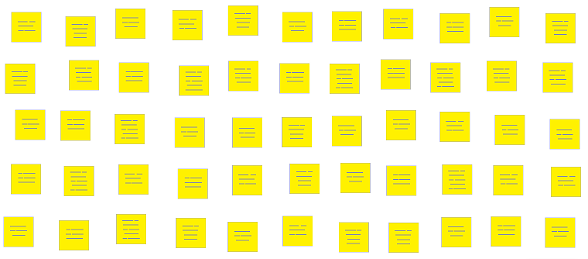
• Have people read the sticky notes, still without talking – and begin to move notes with similar ideas next to each other. This gets the ideas get sorted into categories.
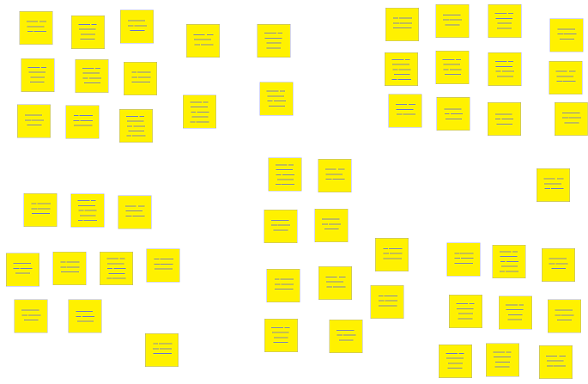
• Allow the team enough time for this. Ideally, each person should read every idea, and the grouping process shouldn’t feel rushed. (Because markers were used to write the ideas, they should be easier to read from a distance.)
• After about 15 minutes, lift the no-talk rule. Have people discuss the groups of ideas that are taking shape. They are to fine-tune these groupings, continuing to move the notes around. Most teams end up with 5-7 stand-alone sets of sticky notes, each containing similar ideas.
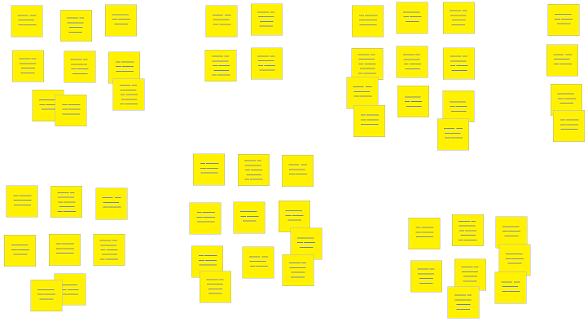
• Now have the team write a label of 1-4 words for each of the resulting sticky-note grouping, to serve as a title. Write each title in dark marker directly above.
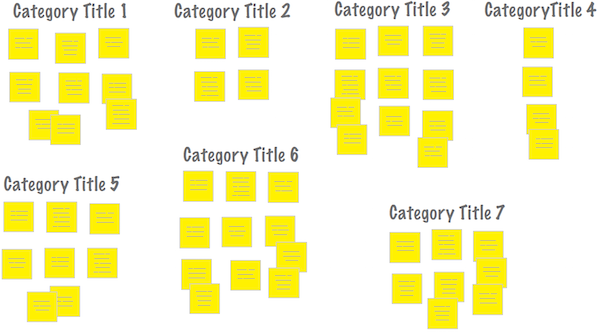
• Now it’s time to “take the temperature” to see which ideas are preferred by the group. For this, give each person 10 colored sticker dots.
• Again without talking, each person is to review all the ideas – and place a dot on each sticky note that has an idea they think should be seriously considered for implementation.
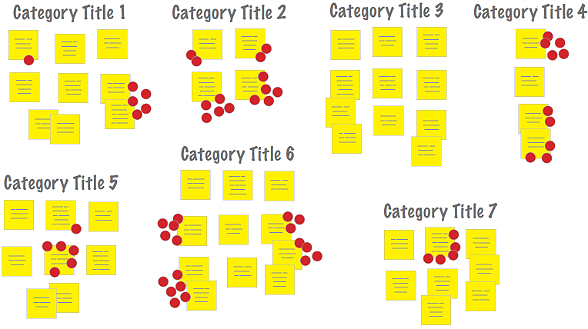
• For an idea that people especially favor, they can place two or more dots.
• After 10 minutes, relax the no-talk rule. Allow people to discuss and even “sell” each other on placing any remaining sticker dots on certain improvement ideas.
By this point, the team will have everyone’s ideas fully unloaded in documented form. Everyone will have read all the ideas. The ideas will be in categories, each with a title. And those sticky dots will point the way to ideas that people deem to have the greatest potential.
The team will be well-positioned to discuss further, to finalize the package of improvements, and then to begin planning its implementation steps.
The truth is, many teams slip and slide through countless meetings before they get to this point. Some never get this far.
With the process spelled out above, you’ll get there in 90 minutes.
Sticky notes and sticky dots aren’t magic, but they’re close.
![]()





